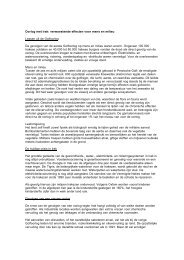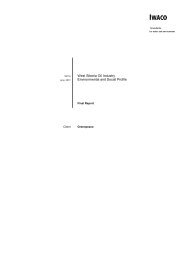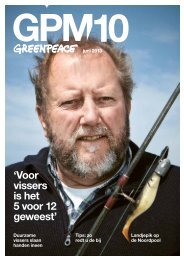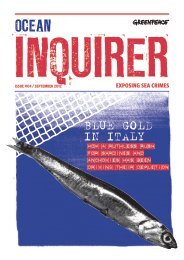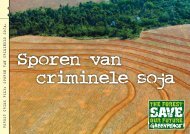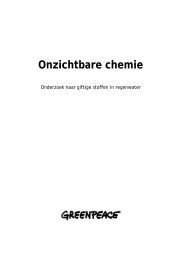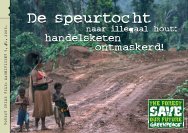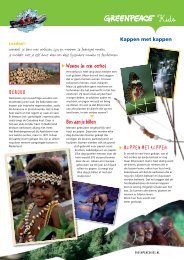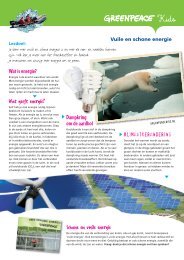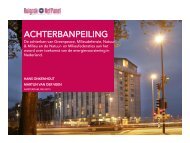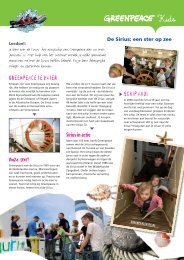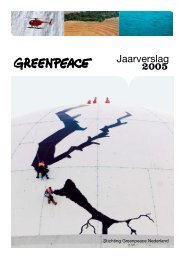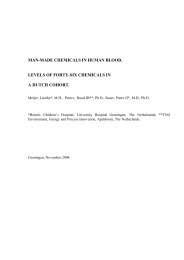HOW PALM OIL SUPPLIERS ARE
HOW PALM OIL SUPPLIERS ARE
HOW PALM OIL SUPPLIERS ARE
Create successful ePaper yourself
Turn your PDF publications into a flip-book with our unique Google optimized e-Paper software.
<strong>HOW</strong><br />
<strong>PALM</strong> <strong>OIL</strong> <strong>SUPPLIERS</strong> <strong>ARE</strong><br />
BURNING UP<br />
BORNEO<br />
www.greenpeace.org
2<br />
NEW EVIDENCE S<strong>HOW</strong>S EXPANSION BY<br />
<strong>PALM</strong> <strong>OIL</strong> <strong>SUPPLIERS</strong> IS DRIVING<br />
SPECIES EXTINCTION IN CENTRAL KALIMANTAN<br />
AND FUELING CLIMATE CHANGE<br />
In November 2007, Greenpeace released Cooking the Climate, an 82-page<br />
report summarising the findings of a two-year investigation that revealed how<br />
the world’s largest food, cosmetic and biofuel companies were driving the<br />
wholesale destruction of Indonesia’s rainforests and peatlands through growing<br />
palm oil consumption.<br />
This follow-up report provides further evidence of the expansion of the palm oil<br />
sector in Indonesia into remaining rainforests, orang-utan habitat and peatlands<br />
in Kalimantan. It links the majority of the largest producers in Indonesia to<br />
Unilever, probably the largest palm oil corporate consumer in the world.<br />
Unilever uses 1.3Mt of palm oil or palm oil derivative every year – about 3%<br />
of global production. 1 About half of Unilever’s palm oil supply comes from<br />
Indonesia. 2 As recently as 2005, Unilever purchased 1 in every 20 tonnes<br />
produced in the country. 3<br />
Unilever has failed to use its power to lead the palm oil sector toward<br />
sustainability, either through its own palm oil purchasing – its primary suppliers<br />
in Indonesia represent over a third of the country’s palm oil production 4 – or<br />
through its role as leader of the Roundtable on Sustainable Palm Oil (RSPO),<br />
whose members represent 40% of global palm oil production. 5<br />
Through analysis of maps, satellite data, and on-the-ground investigations<br />
between February and April 2008, Greenpeace has mapped out how<br />
expansion of the oil palm plantations in Central Kalimantan is fuelling<br />
climate change and helping drive orang-utans to the brink of extinction. As<br />
Greenpeace investigations show, this expansion into the Indonesian territory<br />
of the island of Borneo has in large part been led by companies who are<br />
Unilever suppliers and RSPO members.
3<br />
This destruction is set to get worse. By 2030, demand for palm oil is predicted<br />
to more than double that of 2000. 6 Between 2006 and 2016 alone, palm oil<br />
production is set to increase by close to 15Mt. 7<br />
To meet this growth in demand, major producers including Unilever suppliers<br />
and RSPO members are expanding their plantation areas into forests and<br />
peatlands in Indonesia. 8 This expansion – often illegal 9 and in breach of RSPO<br />
principles and criteria 10 – is not only bad for wildlife, it is also bad for the climate<br />
and bad for governance.<br />
Unilever itself is implicated in the impacts of this expansion through rapidly<br />
growing brand platforms that use significant quantities of palm oil and palm oil<br />
derivatives from companies operating in Indonesia. Product brands and brand<br />
platforms include Dove, Dirt is Good (Persil, Omo, Surf Excel), Knorr,<br />
HeartBrand (Walls) and HealthyHeart (Flora/Becel).<br />
Greenpeace investigations provide new evidence that it is Unilever’s own palm<br />
oil traders and producers (themselves RSPO members) who are leading<br />
‘aggressive expansion’ of the sector that results in the devastation of the last<br />
remaining orang-utan rainforest and peatland habitat in Borneo.<br />
By failing to apply and enforce RSPO principles and criteria to both traders and<br />
producers at group level, Unilever has failed to bring the rapidly expanding<br />
palm oil sector under control. The growth of global brands and brand platforms<br />
such as Dove and Dirt is Good is creating incentives for Unilever’s suppliers to<br />
expand, ‘leading to the devastation of the last remaining rain forests in<br />
Borneo’. 11 As it stands, Unilever suppliers are driving species extinction, climate<br />
change through the significant greenhouse gas (GHG) emissions linked to<br />
deforestation and peatland destruction, and land conflict with forest-dependent<br />
communities.<br />
Given the urgent nature of the crisis, the only solution for the global climate,<br />
the regional environment, the wildlife and the forest-dependent communities<br />
relying upon Indonesia’s forest resources is a moratorium on oil palm<br />
expansion into rainforest and peatland areas.
MAPPING EXTINCTION: <strong>HOW</strong> <strong>OIL</strong> <strong>PALM</strong><br />
CONCESSIONS <strong>ARE</strong> DRIVING HABITAT<br />
DESTRUCTION AND FUELLING CLIMATE CHANGE<br />
FOREST COVER IN BORNEO: DEFORESTATION 1950–2020<br />
Forest cover<br />
Deforestation<br />
1950 2000<br />
ORANG-UTAN DISTRIBUTION IN BORNEO:<br />
POPULATION LOSS 1930–2020<br />
Orang-utan distribution<br />
1930 1999
5<br />
Maps and projections based on 2005 maps compiled by WWF. 12 Forest loss<br />
projections are placed around existing road network. WWF estimates that over<br />
the period 2000–2020 about 17,280,000ha of forest cover will have been lost.<br />
2010 2020<br />
Maps and projections based on 2005 maps compiled by WWF. 13<br />
The 2020 map shows probable orang-utan distribution only in areas<br />
where distribution of 2004 matches predicted forest cover 2020.<br />
2004 2020
THE IMPACTS OF DEFORESTATION<br />
IN INDONESIA<br />
Indonesia now has the fastest deforestation rate<br />
of any major forested country. 14 Losing 2% of its<br />
remaining forest every year, Indonesia has earned<br />
a place in the Guinness World Records. 15<br />
According to World Bank estimates, between 1985 and<br />
1997 alone, 60% of the lowland rainforest of Kalimantan<br />
and Sumatra was destroyed. 16 The United Nations<br />
Environment Program (UNEP) estimates that 98% of<br />
Indonesia’s lowland forest may be destroyed by 2022. 17<br />
Indonesia also holds the global record for GHG emissions from<br />
deforestation, which puts it in third place behind the USA and<br />
China in terms of total GHG emissions from human industry. 18<br />
The destruction of Indonesia’s peat swamp forests alone is one<br />
of the largest sources of GHG emissions in the world. The<br />
largest portion of these emissions is associated with fires to<br />
clear the land for agricultural development. 19<br />
Indonesia’s emissions from destroyed or degraded peatland are<br />
around 1.8Gt CO 2 per year, 20 equivalent to 4% of total GHG<br />
emissions, 21 from less than 0.1% of the world’s land surface. 22<br />
If predicted expansion in oil palm plantations goes ahead, peatland<br />
emissions of CO 2 are set to rise by at least 50% by 2030. 23<br />
Orang-utans – one of our nearest biological relatives – survive<br />
only in the dwindling tropical rainforests of Borneo and<br />
northern Sumatra: 25 they depend on the forest for food and<br />
nesting sites. 26 Cutting down forest for timber or conversion to<br />
plantations is the main cause of their decline, 27 and today<br />
orang-utans are at high risk of extinction in the wild.<br />
Recent Greenpeace analysis and investigations<br />
confirm that expansion in oil palm plantations<br />
by Unilever suppliers is having a serious impact<br />
on their habitat.
8<br />
ORANG-UTAN DISTRIBUTION IN CENTRAL KALIMANTAN:<br />
IMPACT OF 2000–2007 DEFORESTATION AND PROJECTED<br />
IMPACT OF CURRENT <strong>OIL</strong> <strong>PALM</strong> CONCESSIONS<br />
Orang-utan distribution<br />
Deforestation<br />
Oil palm concessions<br />
A 2007 UNEP report recognises that oil palm plantations are<br />
now the leading cause of rainforest destruction in<br />
Indonesia. 33 Between 1991 and 2006, almost 5 million<br />
hectares of new oil palm concession areas have been<br />
established in Indonesia alone, 34 equivalent to over 50<br />
football pitches an hour. Much of this area was previously<br />
forest or peatland. The Indonesian Palm Oil Research<br />
Institute (IOPRI) estimates that two-thirds of all currently<br />
productive oil palm plantations involved deforestation. 35<br />
On top of Indonesia’s existing 6 million hectares of oil<br />
palms, 36 the country’s central government has plans for<br />
another 4 million hectares by 2015 dedicated to biofuel<br />
production alone. 37 Provincial governments are even more<br />
ambitious in terms of oil palm expansion, planning for an<br />
additional 20 million hectares. 38<br />
Kalimantan, the Indonesian portion of the island of Borneo,<br />
which it shares with Malaysia and Brunei, has some of<br />
Indonesia’s largest remaining areas of forest habitat. This is<br />
home to most of the world’s remaining orang-utans.<br />
While most current palm oil production is concentrated in<br />
Riau and North Sumatra, oil palm groups are rapidly<br />
expanding their landbanks and clearing new areas. In West<br />
Kalimantan, by 2007 oil palm concessions had been<br />
granted on more than 3.2 million ha. 39 In Central Kalimantan,<br />
by 2006 oil palm concessions had been granted on 1.1<br />
million ha. 40<br />
As a 2008 Greenpeace investigation reveals, much of this<br />
area – which overlaps critical orang-utan habitat – is being<br />
cleared of valuable forest, the peatlands drained and the<br />
land burned as oil palm plantation area expands.<br />
As orang-utans and other species lose their rainforests to oil<br />
palm plantations, they are deprived of their natural source of<br />
food. Seeking to survive off young palm plants, hungry<br />
orang-utans can become ‘pests’ to oil palm producers, and<br />
plantation workers commonly kill orang-utans to protect the<br />
crop. 41 According to the Centre for Orangutan Protection, at<br />
least 1,500 orang-utans died in 2006 as a result of<br />
deliberate attacks by plantation workers. 42
‘The Bornean orang-utan is classified as Endangered […] indicating that it has a<br />
very high risk of extinction in the wild in the near future. The Sumatran orang-utan<br />
is classified as Critically Endangered […] indicating that it has an extremely high<br />
risk of extinction in the wild in the near future. Since 1900, the number of<br />
Sumatran orang-utans is thought to have fallen by about 91%, with a rapidly<br />
accelerating loss towards the end of the twentieth century.’<br />
United Nations Environment Programme, 2007<br />
9<br />
These maps overlay several data sets. Orang-utan distribution is based on 2005 maps compiled by WWF. 28<br />
The oil palm concession boundaries are based on 2006 work by Forest Watch Indonesia. 29 Deforestation<br />
data is based on 2007 maps developed by Sarvision–Wageningen University in collaboration with the<br />
Indonesian Ministry of Forestry. The first map shows 2004 orang-utan distribution in Central Kalimantan.<br />
The second map projects the impact of 2000–2007 deforestation on orang-utan distribution. The third map<br />
overlays this with oil palm concessions. The fourth map projects that all remaining orang-utan habitat<br />
within concession areas will be lost.
10<br />
PEATLAND DISTRIBUTION IN CENTRAL KALIMANTAN:<br />
PROJECTED IMPACT OF 2006–2007 FIRE HOTSPOTS<br />
IN RELATION TO CURRENT <strong>OIL</strong> <strong>PALM</strong> CONCESSIONS<br />
Peatlands<br />
Fire hotspots<br />
Oil palm concessions<br />
In Central Kalimantan, between 2006 and 2007, one orangutan<br />
rescue centre retrieved more than 200 orang-utans<br />
from oil palm plantations. 43 Greenpeace has evidence of<br />
orang-utans found on concessions belonging to Unilever<br />
suppliers. 44<br />
Oil palm plantation expansion takes place with little oversight<br />
from central or local government. Procedures for<br />
environmental impact assessment, land-use planning and<br />
ensuring a proper process for development of concessions<br />
are neglected.<br />
Many new plantations are located on peat that should be<br />
off-limits to development or degradation according to<br />
Indonesian law. 45 This stipulates that land should not be<br />
allocated for oil palm plantations on peat soils deeper than<br />
2 metres; in addition, activities that damage upstream natural<br />
swamp forests with deep peat (more than 3 metres) are<br />
prohibited. 46 In other words, palm oil development on such<br />
peatlands is illegal. Greenpeace has documented such<br />
clearance on concessions belonging to Unilever suppliers. 47<br />
The use of fire to clear forest areas is the largest source of<br />
GHG emissions in the world. 48 The practice has been illegal<br />
in Indonesia since 1999, 49 yet remains commonplace among<br />
palm oil producers. Greenpeace has identified thousands of<br />
fire hotspots (areas visible on satellite images used to<br />
monitor forest fires) on concessions belonging to Unilever<br />
suppliers during the period 2006–2007. 50<br />
Social conflict, including land rights and resource conflicts,<br />
is often associated with oil palm plantation expansion. 51<br />
Greenpeace has evidence of such conflicts resulting from<br />
the establishment of concessions belonging to Unilever<br />
suppliers. 52<br />
‘The main areas remaining for new<br />
extensive plantations are the large<br />
tracts of tropical peatlands – until<br />
recently virgin rainforest areas.<br />
Over 50% of new plantations are<br />
planned in these peatland areas.’<br />
Wetlands International, 2007<br />
DATE TITLE
11<br />
These maps overlay several data sets: peatland<br />
distribution maps, 30 oil palm concession boundaries<br />
based on 2006 work by Forest Watch Indonesia, 31<br />
and fire hotspots identified by NASA satellite<br />
imagery. 32 The first map shows peatland distribution<br />
in Central Kalimantan. The second map overlays<br />
this with 2006 – 2007 fire hotspot data. The third<br />
map overlays this with oil palm concessions,<br />
showing where they all overlap.<br />
‘Peat swamp forests, which host high densities of<br />
orang-utans, are targeted for palm oil production.<br />
Palm oil plantations are also being developed on<br />
logged-over forest land, preventing recovery.’<br />
United Nations Environment Programme, 2007
12<br />
<strong>PALM</strong> <strong>OIL</strong> <strong>SUPPLIERS</strong> <strong>ARE</strong><br />
LEADING AGGRESSIVE EXPANSION<br />
UNILEVER <strong>SUPPLIERS</strong> SINAR MAS, IOI,<br />
ADM-KUOK-WILMAR, SIME DARBY,<br />
MUSIM MAS, ASTRA AGRO AND<br />
ASIAN AGRI <strong>ARE</strong> PUSHING EXTINCTION<br />
Unilever acknowledges that it has no idea where about 20%<br />
of its palm oil comes from. Of the remaining 80%, it knows<br />
the group supplying the palm oil, but not necessarily the<br />
concession areas from which it originates. 53<br />
Palm oil producers linked to Unilever include Sinar Mas, IOI,<br />
ADM-Kuok-Wilmar, Sime Darby, Musim Mas, Astra Agro and<br />
Asian Agri.<br />
Greenpeace analysis of deforestation maps, satellite data of<br />
fire hotspots, and orang-utan distribution maps, as well as<br />
field investigations of oil palm operations in Central<br />
Kalimantan, show these Unilever suppliers laying claim to<br />
large tracts of forest and peatland, with devastating impacts<br />
on climate and biodiversity.<br />
‘A scenario released by UNEP in 2002<br />
suggested that most natural rainforest in<br />
Indonesia would be degraded by 2032.<br />
Given the rate of deforestation in the past<br />
five years, and recent widespread<br />
investment in oil palm plantations and<br />
biodiesel refineries, this may have been<br />
optimistic. New estimates suggest that 98%<br />
of the forest may be destroyed by 2022,<br />
the lowland forest much sooner.’<br />
United Nations Environment<br />
Programme, 2007<br />
UNILEVER’S TRADERS <strong>ARE</strong> DEALING<br />
WITH BAD COMPANIES<br />
Many of the largest producers in Indonesia that supply<br />
Unilever directly are also traders. This means that a<br />
significant portion of the palm oil they sell may come from<br />
third parties as well as their own operations. In this way,<br />
the identity of groups heavily reliant on deforestation and<br />
peatland clearance is lost in the supply chain. Producer–<br />
traders include Sinar Mas, IOI, ADM-Kuok-Wilmar,<br />
Sime Darby, Musim Mas and Asian Agri.<br />
Another significant palm oil refiner and trader, 54 RSPO<br />
member, 55 and supplier to Unilever is the agricultural<br />
commodity giant Cargill. It is the largest privately-owned<br />
company in the world. 56<br />
Industry sources confirm that roughly half of the palm oil<br />
imported into Europe by Cargill comes from Indonesia. 57<br />
According to export data for 2007, Cargill’s Singapore<br />
trading arm exported palm oil from 15 different oil palm<br />
concession holders in Indonesia. 58 These include some of<br />
Indonesia’s largest palm oil producers: Sinar Mas, Wilmar,<br />
Musim Mas, Astra Agro and Asian Agri. 59<br />
Greenpeace has traced palm oil from a Cargill refinery in<br />
Europe to Knorr, one of Unilever’s high profile brands. Cargill<br />
is also one of Unilever’s European suppliers of palm oil for<br />
ice cream. 60
13<br />
SINAR MAS IS INDONESIA’S LARGEST<br />
<strong>OIL</strong> <strong>PALM</strong> PLANTATION COMPANY<br />
SINAR MAS IS A MAJOR PLAYER IN THE <strong>PALM</strong> <strong>OIL</strong><br />
SECTOR AND IS A MEMBER OF THE RSPO<br />
Sinar Mas is a RSPO member through its oil palm plantation<br />
subsidiary PT SMART. 61<br />
The Sinar Mas Group accounts for almost 10% of palm oil<br />
production in Indonesia. 62 The Group produces not just crude<br />
palm oil, but also palm kernel oil and a wide range of refined<br />
products for both food and industrial purposes. 63<br />
In 2008, Sinar Mas branded itself ‘No. 1 in Indonesia’ 64 for total<br />
planted plantation area. This empire includes 360,000ha of<br />
plantation: some 213,000ha in Sumatra, 135,000ha in<br />
Kalimantan and 12,000ha in Papua. 65<br />
Sinar Mas claims to have ‘the largest land bank in the world<br />
for new plantations’ 66 and has publicly announced plans to<br />
expand its holdings by 1.3 million ha in the heavily forested<br />
province of Papua and in Kalimantan. 67 However, an internal<br />
company presentation obtained by Greenpeace indicates that<br />
the company plans to develop a rainforest area of up to 2.8<br />
million ha in Papua. 68<br />
The Sinar Mas Group is involved in ‘aggressive plantations<br />
expansion’ 69 – ‘the most aggressive new planting programme<br />
among the plantation companies’ 70 – planting 53,000ha in<br />
2007 with plans to plant at least 60,000ha in 2008, 71<br />
representing a growth in plantation area of over a third in a<br />
two-year period. 72 Judging by past operations and known<br />
landbank, the vast majority of this will involve deforestation,<br />
some on peatlands and in critical orang-utan habitat.<br />
UNILEVER’S LINKS TO SINAR MAS<br />
Despite Sinar Mas’ ‘legacy issues’ 73 – including defaulting on<br />
most of the $13.4 billion debt of its APP subsidiary in 2001 74 –<br />
Unilever has maintained a long-standing relationship with the<br />
company. A 1999 Sinar Mas document states: ‘Our major<br />
customers include Cargill and Unilever. These sales were<br />
made through foreign brokers or directly to the importer<br />
located in the countries to which the products were<br />
exported.’ 75 The Sinar Mas 2004 and 2006 Annual Reports 76<br />
also indicate that Unilever has been an important client in<br />
2003–2006, along with Nestlé and Carrefour. 77<br />
SINAR MAS IS IMPLICATED IN RECENT OR ONGOING<br />
FOREST DESTRUCTION IN CENTRAL KALIMANTAN<br />
Deforestation on orang-utan habitat<br />
Deforestation on peatlands<br />
Fire hotspots<br />
Remaining forest on orang-utan habitat<br />
Remaining forest on peatlands
14<br />
the Group’s strategy of growing its core<br />
palm oil business […]. It will provide<br />
immediate addition to planted hectarage<br />
as well as substantial suitable land bank<br />
for sustained business growth, hence<br />
providing the Group with the opportunity<br />
to capitalise on the very favourable<br />
outlook for the oil palm industry. The<br />
plantations […] shall be cultivated in<br />
compliance with sustainable agricultural<br />
practices and principles in accordance<br />
with the principles and criteria of the<br />
Roundtable on Sustainable Palm Oil.’<br />
IOI Announcement, 2007<br />
‘The proposed Joint Venture is in line with<br />
IOI AND UNILEVER’S LONG HISTORY<br />
IOI IS A MAJOR PLAYER IN THE <strong>PALM</strong> <strong>OIL</strong><br />
SECTOR AND IS A MEMBER OF THE RSPO<br />
The IOI Group has a plantation land holding of nearly<br />
170,000ha in Malaysia (of which 149,000ha is planted) and<br />
another 152,000ha in Kalimantan in Indonesia (of which<br />
43,000ha is planted) via a joint venture, 78 with 72% of its<br />
Indonesian holdings yet to be planted. These holdings<br />
include 63,000ha in Central Kalimantan. 79<br />
IOI has been involved in oleo chemicals since 1980. 80 In<br />
2006, IOI emerged as the world’s largest producer of oleo<br />
chemicals – chemicals often derived from palm oil that are<br />
used in cosmetics, laundry detergents and other household<br />
products. IOI has a total fatty acid production capacity of<br />
700,000 tonnes a year. 81<br />
In 2007, the Group produced 790,000 tonnes of crude<br />
palm oil representing more than 2% of global production. 82<br />
It also produced 185,000 tonnes of palm kernel oil, 83<br />
representing more than 4% of global production. 84<br />
In 2007, IOI is estimated to have produced around 180,000<br />
tonnes of crude palm oil in Indonesia, 85 accounting for just<br />
over 1% of Indonesian production.<br />
UNILEVER’S LINKS TO IOI<br />
IOI has had a long association with Unilever. In 2002–2003,<br />
IOI bought the palm oil refining company Loders Croklaan<br />
from Unilever 86 at the same time as it acquired Unilever’s<br />
Malaysian oil palm plantations. 87 Announcing the deal,<br />
Unilever stated: ‘Loders Croklaan will continue to supply<br />
Unilever with specialty products.’ 88<br />
In 2007 and 2008, IOI Rotterdam confirmed that it supplies<br />
Unilever from its Dutch refineries. 89<br />
In 2008, Unilever named IOI as one of its principle<br />
suppliers. 90<br />
IOI IS IMPLICATED IN RECENT OR ONGOING FOREST<br />
DESTRUCTION IN CENTRAL KALIMANTAN<br />
Deforestation on orang-utan habitat<br />
Deforestation on peatlands<br />
Fire hotspots<br />
Remaining forest on orang-utan habitat<br />
Remaining forest on peatlands
15<br />
ADM-WILMAR-KUOK IS ONE OF THE WORLD’S<br />
LARGEST PRIVATELY OWNED GROUPS<br />
THE ADM-KUOK-WILMAR ALLIANCE IS A MAJOR<br />
PLAYER IN THE <strong>PALM</strong> <strong>OIL</strong> SECTOR AND IS A<br />
MEMBER OF THE RSPO<br />
Wilmar is a RSPO member. It claims to be the world’s largest<br />
producer of palm oil based biodiesel. 91 The Group – effectively<br />
a shareholder alliance between ADM 92 and the Kuok family 93 –<br />
also controls about 570,000ha of concession area (just over a<br />
third of this has been cleared and planted), palm oil refineries<br />
and biodiesel plants across Indonesia and Malaysia. 94 Of this,<br />
some 493,000ha is in Indonesia. 95<br />
In 2007, Indonesian production for the Wilmar Group was<br />
around 540,000 tonnes of crude palm oil, accounting for<br />
more than 3% of Indonesia production. 96 Although Wilmar<br />
owns substantial concession areas, more than 55% of its<br />
palm oil production comes from third party plantations. 97<br />
The Kuok Group was founded by Robert Kuok Hock-Nien,<br />
the uncle of William Kuok, one of Wilmar’s founders.<br />
According to Forbes, in 2005, Robert Kuok Hock-Nien was<br />
the richest man in Asia. 98<br />
The US-headquartered ADM claims to be the world’s leading<br />
processor of agricultural crops and Europe’s leader in<br />
biofuels. 99 The company also trades crude palm oil on the<br />
Chicago futures market (meaning contracts are signed and<br />
traded months ahead of delivery). 100 ADM is one of Cargill’s<br />
main competitors in the palm oil sector, 101 although through<br />
Wilmar, the alliance also trades with Cargill. 102<br />
UNILEVER’S LINKS TO ADM-KUOK-WILMAR<br />
In a 2006 declaration to institutional investors, Wilmar<br />
announced that its key international customers include Procter<br />
& Gamble, Cargill, Unilever, Nestlé and China Grains & Oils<br />
Group Corporation. 103<br />
In the UK, most if not all of Unilever’s palm oil is supplied by<br />
ADM. 104 The company operates a refinery immediately next<br />
door to Unilever’s margarine factory outside London. Reported<br />
as the largest margarine factory in the world, 105 the Unilever<br />
factory produces brands such as Flora and Bertolli. 106 The<br />
ADM refinery handles more than 300,000 tonnes of edible oils<br />
a year, including palm oil. 107 In addition to supplying products<br />
to the Unilever factory, the company delivers products to a<br />
wide range of food factories around the UK and overseas. 108<br />
Unilever also has trade links to the Kuok Group. For instance,<br />
Unilever Pakistan purchased almost 100 tonnes of palm kernel<br />
oil from the Group in August 2007. 109 Kuok Group is known<br />
to source palm oil from Astra Agro as well as other third-party<br />
suppliers. 110<br />
In 2008, Unilever named Kuok-Wilmar as one of its<br />
principle suppliers. 111<br />
ADM-KUOK-WILMAR IS IMPLICATED IN RECENT OR ONGOING<br />
FOREST DESTRUCTION IN CENTRAL KALIMANTAN<br />
Deforestation on orang-utan habitat<br />
Deforestation on peatlands<br />
Fire hotspots<br />
Remaining forest on orang-utan habitat<br />
Remaining forest on peatlands
16<br />
SIME DARBY – THE WORLD’S LARGEST<br />
<strong>OIL</strong> <strong>PALM</strong> PLANTATIONS COMPANY<br />
SIME DARBY IS A MAJOR PLAYER IN THE <strong>PALM</strong> <strong>OIL</strong><br />
SECTOR AND IS A MEMBER OF THE RSPO<br />
The 2007 merger of Sime Darby, Golden Hope Plantations<br />
and Kumpulan Guthrie established Sime Darby Plantation as<br />
the world’s largest palm oil producer, with the potential of<br />
producing 8% of the world’s total palm oil output. 112 This<br />
publicly-listed group, which runs plantations, refineries and<br />
biodiesel plants across Indonesia and Malaysia, 113 is controlled<br />
by the Malaysian government. 114<br />
Sime Darby is a RSPO member. 115<br />
The Group is focusing on Indonesia for expanding its<br />
business. 116<br />
With total plantation assets of nearly 550,000ha, Sime Darby’s<br />
nearly 200,000ha of oil palm concessions in Indonesia makes<br />
up for more than a third of its total holdings. 117 Prior to the<br />
merger, Golden Hope controlled a total area of 60,000ha in<br />
West Kalimantan, Indonesia, of which 13,000ha were planted<br />
with oil palms. 118 Kumpulan Guthrie owned and operated 56<br />
plantation estates in Indonesia with a total land area of<br />
220,000ha spread over Sumatra, Kalimantan and Sulawesi, 119<br />
of which 175,000ha had been planted. 120<br />
UNILEVER’S LINKS TO SIME DARBY<br />
The Group is a major supplier to Unilever. 122<br />
There is a long standing relationship between Unilever and<br />
companies now part of Sime Darby Group.<br />
In 2002, Golden Hope bought Unimills, Unilever’s oil refinery<br />
in Rotterdam in The Netherlands. 123 Unimills is the second<br />
largest diversified oil and fats blend manufacturer in Europe 124<br />
– an industry that uses large quantities of palm oil. A recent<br />
announcement by Sime Darby confirmed that Unilever is a<br />
major customer of the Golden Hope (now Sime Darby)<br />
Unimills refinery in Rotterdam. 125<br />
In 2008, Unilever named the Sime Darby Group, including<br />
Golden Hope and Kumpulan Guthrie, as one of its principle<br />
suppliers. 126<br />
Golden Hope is known to trade palm oil sourced from the<br />
Musim Mas Group in Indonesia. 127<br />
SIME DARBY IS IMPLICATED IN RECENT OR ONGOING<br />
FOREST DESTRUCTION IN CENTRAL KALIMANTAN<br />
Fire hotspots<br />
In 2007, Indonesian production for the Sime Darby Group was<br />
around 800,000 tonnes of crude palm oil, accounting for<br />
nearly 5% of Indonesia production. 121<br />
‘We are the first plantation<br />
company in Malaysia to<br />
receive the Global 500<br />
Award by the United<br />
Nations Environment<br />
Programme (UNEP) for our<br />
“Zero Burning” practices.’<br />
Golden Hope (now part<br />
of Sime Darby)
17<br />
MUSIM MAS<br />
MUSIM MAS IS A MAJOR PLAYER IN THE <strong>PALM</strong> <strong>OIL</strong><br />
SECTOR AND IS A MEMBER OF THE RSPO<br />
In 2006, Musim Mas had 126,000ha of landholdings in<br />
Indonesia, 128 over half of these in Central Kalimantan. 129<br />
In 2007, the Group produced around 300,000 tonnes of<br />
crude palm oil, accounting for 2% of Indonesia’s production. 130<br />
UNILEVER’S LINKS TO MUSIM MAS<br />
Unilever supplier Golden Hope is known to source palm oil<br />
from the Musim Mas Group in Indonesia. 134<br />
Unilever trader Cargill is known to source palm oil from the<br />
Musim Mas Group in Indonesia. 135<br />
In 2008, Unilever named Musim Mas as one of its principle<br />
suppliers. 136<br />
The company seeks RSPO certification for all of its operations.<br />
This includes certification of the Central Kalimantan<br />
concession PT Globalindo Alam Perkasa in September 2009.<br />
As of December 2007, 2,531ha of this concession (15%) was<br />
reported planted. 131 Greenpeace has evidence that in<br />
December 2007, a baby orang-utan was captured in this<br />
concession area, indicating that it has high conservation<br />
values (HCV). The concession is located on peat, 132 in some<br />
areas over 4 metres deep, and had fire hotspots in 2006 and<br />
2007, 133 implying recent clearance.<br />
MUSIM MAS IS IMPLICATED IN RECENT OR ONGOING<br />
FOREST DESTRUCTION IN CENTRAL KALIMANTAN<br />
Deforestation on orang-utan habitat<br />
Deforestation on peatlands<br />
Fire hotspots<br />
Remaining forest on orang-utan habitat<br />
Remaining forest on peatlands<br />
Oil palm concession PT Globalindo Alam Perkasa controlled by<br />
Unilever supplier Musim Mas. The Google Earth image shows<br />
significant forest cover within the concession boundaries. The first<br />
detail map shows 2004 orang-utan habitat and deforestation<br />
2000–2007. The second map shows peatland areas and 2006–2007<br />
fire hotspots. This suggests active deforestation in the concession.
18<br />
ASIAN AGRI<br />
ASIAN AGRI IS A MAJOR PLAYER IN THE <strong>PALM</strong> <strong>OIL</strong><br />
SECTOR AND IS A MEMBER OF THE RSPO<br />
RSPO member Asian Agri 137 is part of the Raja Garuda Mas<br />
Group, which owns the pulp and paper giant APRIL. 138 Raja<br />
Garuda Mas is controlled by Sukanto Tanoto, whom Forbes<br />
lists as the richest man in Indonesia. 139 The Jakarta Post<br />
reports that Asian Agri is currently under investigation for<br />
evasion of taxes worth up to Rp1.3 trillion ($140 billion), with<br />
the possibility of criminal charges against its top executives. 140<br />
ASIAN AGRI IS IMPLICATED IN RECENT OR ONGOING<br />
FOREST DESTRUCTION IN CENTRAL KALIMANTAN<br />
Deforestation on orang-utan habitat<br />
Deforestation on peatlands<br />
Fire hotspots<br />
Remaining forest on orang-utan habitat<br />
Asian Agri controls over 160,000ha of planted plantation land<br />
in Riau, Jambi and North Sumatra: 141 100,000ha in<br />
concessions and 60,000ha in smallholder areas. 142<br />
In 2007, the Group refined about 1.5Mt of crude palm oil,<br />
about 9% of Indonesia’s production. 143<br />
UNILEVER’S LINKS TO ASIAN AGRI<br />
Unilever trader Cargill is known to source palm oil from the<br />
Asian Agri Group in Indonesia. 144<br />
In 2008, Unilever named Asian Agri as one of its principle<br />
Oil palm concession PT Karya Dewi Putra in<br />
Central Kalimantan controlled by Unilever<br />
supplier Asian Agri. The large area map shows<br />
that the concession was still forested in 2007.<br />
The first detail map shows 2004 orang-utan<br />
habitat and deforestation 2000–2007. The second<br />
map shows 2006–2007 fire hotspots. This<br />
suggests active deforestation in the concession.<br />
suppliers. 145 ‘Asian Agri has a very strict no-burn policy.<br />
During either initial planting (land clearing)<br />
or replanting, Asian Agri utilises mechanical<br />
means to clear land.’<br />
Asian Agri website
19<br />
ASTRA AGRO<br />
ASTRA AGRO IS A MAJOR PLAYER IN THE <strong>PALM</strong> <strong>OIL</strong><br />
SECTOR<br />
Astra Agro is controlled by Indonesia’s car manufacturer PT<br />
Astra International.<br />
In 2007, the Group produced 921,000 tonnes of crude palm<br />
oil, accounting for 5.5% of Indonesia’s production. 149<br />
UNILEVER’S LINKS TO ASTRA AGRO<br />
Unilever trader Cargill is known to source palm oil from the<br />
Astra Agro Group in Indonesia.<br />
During 2007, the Group increased its landholdings by 70% to<br />
nearly 400,000ha. 146 Of this, some 235,000ha is planted 147<br />
(90,000ha in Kalimantan, 107,000ha in Sumatra and<br />
38,000ha in Sulawesi). 148 Some 40% remains to be planted.<br />
ASTRA AGRO IS IMPLICATED IN RECENT OR ONGOING<br />
FOREST DESTRUCTION IN CENTRAL KALIMANTAN<br />
Deforestation on orang-utan habitat<br />
Deforestation on peatlands<br />
Fire hotspots<br />
Remaining forest on orang-utan habitat Oil palm concessions PT Agro Lestari Sentosa<br />
in Central Kalimantan controlled by Unilever<br />
supplier Astra Agro. The large area map shows<br />
that the concessions were still forested in 2007.<br />
The first detail map shows 2004 orang-utan<br />
habitat and deforestation 2000–2007. The second<br />
map shows 2006–2007 fire hotspots. This<br />
suggests recent deforestation in the concession.
20<br />
CONCESSIONS CONTROLLED BY UNILEVER<br />
<strong>SUPPLIERS</strong> IN THE <strong>ARE</strong>A OF LAKE SEMBULUH<br />
IN CENTRAL KALIMANTAN<br />
Sinar Mas<br />
IOI<br />
ADM-Kuok-Wilmar<br />
Sime Darby<br />
Musim Mas<br />
Asian Agri<br />
Astra Agro
CLIMATE AND BIODIVERSITY IMPACTS<br />
OF <strong>PALM</strong> <strong>OIL</strong> <strong>SUPPLIERS</strong><br />
IN CENTRAL KALIMANTAN 150<br />
21<br />
<strong>OIL</strong> <strong>PALM</strong> GROUPS Sinar Mas IOI Wilmar Sime Darby Musim Mas Asian Agri Astra Agro<br />
Share of Crude Palm<br />
Oil (CPO) production<br />
in Indonesia (2007)<br />
10% 1.1% 3.2% 4.7% 2.0% 9.0% 5.5%<br />
Oil Palm Concessions<br />
in Central Kalimantan<br />
Number of identified oil 6 4 15 3 6 1 7<br />
palm concessions<br />
Total area (ha) 68,845 48,779 255,714 49,086 38,925 26,437 111,810<br />
Peatland Areas<br />
Number of concessions 3 1 12 1 4 0 1<br />
on peatland<br />
Actual area on peat (ha) 8,067 2,981 57,591 1,626 10,039 0 23,269<br />
Total peatland carbon<br />
store / CO 2 ) equivalent<br />
(CO 2 e)<br />
12.1Mt<br />
(44.5Mt<br />
CO 2 e)<br />
3.6Mt<br />
(13.2Mt<br />
CO 2 e)<br />
35.7Mt<br />
(131.4Mt<br />
CO 2 e)<br />
0.73Mt<br />
(2.7Mt<br />
CO 2 e)<br />
11.7Mt<br />
(42.9Mt<br />
CO 2 e)<br />
0 58.4Mt<br />
(214Mt<br />
CO 2 e)<br />
Number of concessions 2 1 2 0 0 0 1<br />
on deep peat >2m<br />
Area (ha) 6,597 1,685 6,693 0 2,283 0 23,269<br />
Number of concessions<br />
with deforestation<br />
on peatland<br />
(2000 to July 2007)<br />
1 1 9 0 4 0 1<br />
Number of concessions<br />
with remaining forest on<br />
peatland in July 2007<br />
Orang-utan Habitat<br />
Number of concessions<br />
on 2004 orang-utan<br />
habitat<br />
Number of concessions<br />
with deforestation<br />
on orang-utan habitat<br />
(2000 to July 2007)<br />
Number of concessions<br />
with significant remaining<br />
forest on orang-utan<br />
habitat in July 2007<br />
Forest Fires Hotspots<br />
(2006-2007)<br />
Number of concessions<br />
2006<br />
Number of concessions<br />
2007<br />
2 1 7 0 3 0 0<br />
5 2 15 2 6 1 4<br />
1 1 9 0 4 0 1<br />
3 2 8 0 5 1 3<br />
260 fire<br />
hotspots<br />
on 5<br />
concessions<br />
62 fire<br />
hotspots<br />
on 3<br />
concessions<br />
180 fire<br />
hotspots<br />
on 4<br />
concessions<br />
33 fire<br />
hotspots<br />
on 4<br />
concessions<br />
1117 fire<br />
hotspots<br />
on 4<br />
concessions<br />
13 fire<br />
hotspots<br />
on 7<br />
concessions<br />
70 fire<br />
hotspots<br />
on 3<br />
concessions<br />
3 fire<br />
hotspots<br />
on 2<br />
concessions<br />
135 fire<br />
hotspots<br />
on 3<br />
concessions<br />
53 fire<br />
hotspots<br />
on 3<br />
concessions<br />
266 fire<br />
hotspots<br />
on 1<br />
concession<br />
12 fire<br />
hotspots<br />
on 1<br />
concession<br />
442 fire<br />
hotspots<br />
on 7<br />
concessions<br />
264 fire<br />
hotspots<br />
on 7<br />
concessions
22<br />
<strong>OIL</strong> <strong>PALM</strong> CONCESSIONS IN CENTRAL KALIMANTAN<br />
CONTROLLED BY UNILEVER <strong>SUPPLIERS</strong><br />
Sinar Mas<br />
IOI<br />
ADM-Kuok-Wilmar<br />
Sime Darby<br />
Musim Mas<br />
Asian Agri<br />
Astra Agro<br />
FOREST COVER IN CENTRAL KALIMANTAN: IMPACT OF <strong>OIL</strong><br />
<strong>PALM</strong> CONCESSIONS CONTROLLED BY UNILEVER <strong>SUPPLIERS</strong><br />
Forest cover<br />
Deforestation<br />
Oil palm concessions<br />
Evidence of 2000–2007 deforestation on oil<br />
palm concessions PT Bhumitama Gunajaya<br />
Agro and PT Setya Kisma Usaha controlled<br />
by Unilever suppliers IOI and Sinar Mas
PEATLANDS IN CENTRAL KALIMANTAN: IMPACT OF 2006–2007<br />
FIRE HOTSPOTS IN RELATION TO <strong>OIL</strong> <strong>PALM</strong> CONCESSIONS<br />
CONTROLLED BY UNILEVER <strong>SUPPLIERS</strong><br />
23<br />
Peatlands<br />
Fire hotspots<br />
Oil palm concessions<br />
Evidence of 2006–2007 fire hotspots on oil<br />
palm concessions in the Lake Sembuluh<br />
area controlled by Unilever supplier Wilmar<br />
5 October 2006: Fire hotspots in Central Kalimantan<br />
as documented by MODIS satellite imagery – detail<br />
map shows multiple fire hotspots on concessions in<br />
the Lake Sembuluh area controlled by Unilever<br />
supplier Wilmar
24<br />
ORANG-UTAN DISTRIBUTION IN CENTRAL KALIMANTAN:<br />
IMPACT OF <strong>OIL</strong> <strong>PALM</strong> CONCESSIONS CONTROLLED<br />
BY UNILEVER <strong>SUPPLIERS</strong><br />
Orang-utan distribution<br />
Deforestation<br />
Oil palm concessions<br />
Oil palm concessions PT Bawaal Sawit Tunas<br />
Belum and PT Alam Sawit Permai controlled<br />
by Unilever supplier Wilmar shows significant<br />
overlap with orang-utan habitat.<br />
DATE TITLE<br />
Oil palm concessions PT Unggul Lestari controlled by<br />
Unilever supplier Musim Mas, PT Karya Makmur<br />
Bahagia controlled by Unilever supplier IOI, and PT<br />
Karya Dewi Putra controlled by Unilever supplier Asian<br />
Agri shows significant overlap with orang-utan habitat.
25<br />
Oil palm concessions PT Bhumitama Gunajaya<br />
Agro controlled by Unilever supplier IOI and PT<br />
Setya Kisma Usaha controlled by Unilever supplier<br />
Sinar Mas. The map shows the concessions are<br />
located on orang-utan habitat. The photos taken<br />
during Greenpeace field investigations document<br />
active deforestation on the concessions and show<br />
the area is important orang-utan habitat. Coloured<br />
dots in the map locate where two of the photos<br />
were taken.<br />
ORANG-UTAN NEST
26<br />
TIME FOR ACTION: A MORATORIUM ON<br />
<strong>OIL</strong> <strong>PALM</strong> EXPANSION INTO INDONESIA’S<br />
RAINFORESTS AND PEATLANDS<br />
Protecting the world’s remaining forests is crucial to efforts<br />
to stabilise the climate, to preserve global biodiversity and<br />
to ensure the livelihoods of millions of people who depend<br />
on forests.<br />
Forest destruction is responsible for about one fifth of global<br />
GHG emissions – Indonesia and the Amazon are by far the<br />
two largest sources of GHG emissions from deforestation.<br />
Emissions from Indonesia’s degraded peatlands represent 4%<br />
of global GHG emissions, but the area of degraded peatlands<br />
involved is relatively small – about 10 million hectares or less<br />
than 0.1% of the Earth’s land surface.<br />
If we are to prevent dangerous global climate change, we<br />
need a global effort to halt forest destruction as well as<br />
bringing about a drastic reduction in our use of coal, oil and<br />
gas by using energy more efficiently and utilising cleaner<br />
sources of energy.<br />
In order to help protect the climate, Greenpeace is calling for<br />
an end to deforestation in Indonesia – the largest source of<br />
GHG emissions from deforestation.<br />
A halt to further rainforest destruction in Indonesia is also<br />
critical to ensuring the future for critically endangered species<br />
such as the orang-utan.<br />
WHAT DOES THE INDONESIAN GOVERNMENT<br />
NEED TO DO?<br />
STOP THE PROBLEM: ZERO DEFORESTATION<br />
Establish a moratorium on forest clearance and peatland<br />
degradation and ensure enforcement of the moratorium.<br />
START THE SOLUTION: CLIMATE PROTECTION<br />
Prioritise protection of remaining peat swamp forests and other<br />
forest areas with high carbon storage capacity, biodiversity<br />
values and benefits for indigenous peoples and other local<br />
communities.<br />
START THE SOLUTION: CUT ONGOING EMISSIONS<br />
Rehabilitate degraded peatland areas with natural and<br />
native flora.<br />
WHAT DO UNILEVER AND THE <strong>PALM</strong> <strong>OIL</strong><br />
SECTOR NEED TO DO?<br />
STOP THE PROBLEM: SUPPORT ZERO<br />
DEFORESTATION<br />
Support a moratorium on forest clearance and peatland<br />
degradation.<br />
START THE SOLUTION: CLEAN UP THE TRADE<br />
Do not trade with those engaged in deforestation and<br />
peatland degradation.<br />
Inform suppliers that purchasers will no longer buy from<br />
companies engaged in forest conversion and peatland<br />
degradation.<br />
‘A moratorium will be a strong signal. [It] can be a first step in countering peatland<br />
degradation [,] to buy time to maximise the new opportunity of carbon finance.<br />
A moratorium needs to be part of a longer-term strategy of land-use planning.’<br />
Yogyakarta statement, endorsed by the Indonesian Minister of the<br />
Environment, August 2007
‘The simplest and most effective measure to prevent a further increase<br />
in fires and CO 2 emissions is by conservation of remaining peat<br />
swamp forests and rehabilitation of degraded peat swamp forests.’<br />
Wetlands International, 2006
28<br />
PICTURE CAPTIONS<br />
Cover<br />
16 October 2006: Fire on Central Kalimantan oil palm plantation<br />
©www.films4.org<br />
4 October 2007: Haze from plantation fires clouds the Kapuas River in Central<br />
Kalimantan ©Greenpeace/Behring<br />
13 November 2006: Orang-utan found on oil palm concession PT Mustika<br />
Sembuluh in Central Kalimantan now controlled by Unilever supplier Wilmar –<br />
rough treatment by plantation workers has left it with a broken arm<br />
©Greenpeace<br />
6 August 2007: Digger at work on oil palm concession PT Sarana Titian<br />
Permata in Central Kalimantan now controlled by Unilever supplier Wilmar –<br />
the sign on tree reads ‘Do not hunt the wildlife’ ©www.films4.org<br />
pp1-2<br />
6 August 2007: Deforestation on oil palm concession PT Sarana Titian<br />
Permata in Central Kalimantan now controlled by Unilever supplier Wilmar<br />
©www.films4.org<br />
Unilever products ©Greenpeace/Novis<br />
pp6-7<br />
25 August 2006: Two photos of burning peatland oil palm concession areas<br />
in Riau – use of fire for land clearance is illegal but common in the industry,<br />
and every year cause a thick smog-like haze over the entire region,<br />
threatening the health of millions of people and contributing to the problem of<br />
climate change ©Greenpeace/Dithajohn<br />
13 November 2006: Orang-utan baby trapped by workers on an oil palm<br />
plantation in Central Kalimantan – the baby’s mother was found dead ©BOS<br />
Foundation<br />
1 October 1997: Sumatran rainforest on fire due to climate change effects<br />
from El Niño ©Lily/Greenpeace<br />
p9<br />
26 September 2006: Orang-utan marooned on deforested oil palm<br />
concession in Central Kalimantan ©BOS International<br />
p11<br />
13 April 2008: Crane draining peatland in the vicinity of oil palm concession<br />
PT Tapian Nadenggan controlled by Unilever supplier<br />
Sinar Mas ©Greenpeace<br />
p12<br />
Google image of the Cargill refinery in Rotterdam ©Google Earth<br />
p13<br />
February 2008: Oil palm concession PT Setya Kisma Usaha in Central<br />
Kalimantan controlled by Unilever supplier Sinar Mas shows clear evidence of<br />
burning – the concession has peatland areas and is located on orang-utan<br />
habitat ©Greenpeace<br />
13 April 2008: Road building in the vicinity of oil palm concession PT Tapian<br />
Nadenggan in Central Kalimantan controlled by Unilever supplier Sinar Mas<br />
©Greenpeace<br />
p15<br />
6 August 2007: Female agile gibbon with broken nose captured by plantation<br />
workers on oil palm concession PT Kerry Sawit Indonesia in Central<br />
Kalimantan controlled by Unilever supplier Wilmar – the species is listed as<br />
endangered by the IUCN ©www.films4.org<br />
p16<br />
Google image of the Unimills refinery in Rotterdam ©Google Earth<br />
p17<br />
27 December 2007: Orang-utan baby caught by plantation workers on oil<br />
palm concession PT Globalindo Alam Perkasa in Central Kalimantan controlled<br />
by Unilever supplier Musim Mas – the baby died soon after this image was<br />
taken ©Greenpeace<br />
Google image of oil palm concession PT Globalindo Alam Perkasa in Central<br />
Kalimantan controlled by Unilever supplier Musim Mas – remaining forested<br />
orang-utan habitat on peatland area is clearly visible ©Google Earth<br />
p20<br />
Google image of the Lake Sembuluh region of Central Kalimantan overlaid<br />
with concession areas controlled by Unilever’s palm oil suppliers ©Google<br />
Earth<br />
p23<br />
5 October 2006: Fire hotspots in Central Kalimantan as documented by<br />
MODIS satellite imagery ©Jeff Schmaltz, Earth Observatory/MODIS Rapid<br />
Response team<br />
p25<br />
February 2008: PT Bhumitama Gunajaya Agro oil palm concession in Central<br />
Kalimantan controlled by Unilever supplier IOI shows clear evidence of<br />
drainage – the concession has peatland areas and is located on orang-utan<br />
habitat ©Greenpeace<br />
15 April 2008: Baby orang-utan captured in the Pangkalan Bun area near<br />
palm oil concessions controlled by Unilever suppliers IOI and Sinar Mas<br />
©Greenpeace<br />
13 April 2008: Isolated orang-utan nest in Central Kalimantan in the vicinity of<br />
oil palm concession PT Tapian Nadenggan controlled by Unilever supplier<br />
Sinar Mas ©Greenpeace<br />
p27<br />
14 April 2008: Sunset over threatened orang-utan habitat inside a concession<br />
controlled by Unilever supplier Sinar Mas ©Greenpeace<br />
Back cover<br />
15 April 2008: Baby orang-utan captured in the Pangkalan Bun area near<br />
palm oil concessions controlled by Unilever suppliers IOI and Sinar Mas<br />
©Greenpeace<br />
p14<br />
12 April 2008: Crane clearing forest area on oil palm concession PT<br />
Bhumitama Gunajaya Agro in Central Kalimantan controlled by Unilever<br />
supplier IOI ©Greenpeace
29<br />
ENDNOTES<br />
1 Unilever uses 1.3Mt of palm oil or palm oil<br />
derivative every year. Of this, about 800,000<br />
tonnes is for food use and the remainder is for<br />
industrial use, of which approximately 300,000<br />
tonnes comes from palm kernel oil (Personal<br />
communication, 10 April 2008). This represents<br />
about 3% of global palm and palm kernel oil<br />
production in 2007 (42.4Mt). Source: Oilworld<br />
ISTA Mielke (2008) ‘‘Oilworld statistics update’<br />
14 March 2008’ together with an estimate of<br />
palm kernel oil based on FAO 2006 figures.<br />
2 Clay (2005)<br />
3 Clay (2005)<br />
4 See table in this document<br />
5 Adam Harrison, WWF, letter to Greenpeace, 19<br />
October 2007; this is equivalent to 17Mt given<br />
that global production for 2007 is 38.13Mt<br />
(Source: Oilworld ISTA Mielke (2008) ‘Oilworld<br />
statistics update’ 14 March 2008)<br />
6 FAO (2006): 56<br />
7 Vegetable oils, here defined as rapeseed oil,<br />
soyabean oil, sunflower seed oil and palm oil,<br />
except in Japan where it excludes sunflower<br />
seed oil, will rise by 31.7Mt; palm oil by 14.9Mt.<br />
OECD-FAO (2007b)<br />
8 cf Annual Reports of Sinar Mas, Asian Agri<br />
(RGM), Wilmar, Musim Mas, Genting, IOI and<br />
others<br />
9 For instance, concessions on peatlands over 2<br />
metres deep or use of fire for clearance.<br />
10 Eg Criterion 7.3 which prohibits conversion of<br />
areas with High Conservation Values (See<br />
RSPO ‘Principles and Criteria for Sustainable<br />
Palm Oil Production’ (2007)<br />
www.rspo.org/resource_centre/RSPO%20Princi<br />
ples%20&%20Criteria%20Document.pdf<br />
11 Unilever’s contribution to Review of EU Biofuels<br />
Directive Public Consultation Exercise, April-July<br />
2006, Energy and Transport Directorate-<br />
General, European Commission<br />
12 WWF (2005) Forest cover 2000 is based on<br />
LANDSAT ETM imagery 1999 and 2000,<br />
modified by images from 2002. Forest cover<br />
2010 and 2020 is a projection based on<br />
LANDSAT imagery 2000.<br />
13 WWF (2005) Orang-utan distribution 1930 and<br />
1999 based Rijksen and Meijaard (1999)<br />
Modified by removing occurrence above 500 m<br />
asl, except for Crocker Range National Park, Mt.<br />
Kinabalu and some areas in southeast Sabah.<br />
Orang-utan distribution 2004 and 2020 in<br />
Kalimantan based on ‘Orang-utan PHVA<br />
(Population and Habitat Viability Assessment)’<br />
(2004) Modified by removing occurrence above<br />
500 m asl. Orang-utan distribution 2004 and<br />
2020 in Sabah based on Ancrenaz et al. (2005)<br />
14 FAO (2005)<br />
15 Greenpeace SE Asia, ‘Indonesia makes it to<br />
2008 Guinness World Records as fastest forest<br />
destroyer on the planet’ 3 May 2007<br />
www.greenpeace.org/seasia/en/news/indonesia<br />
-makes-it-to-2008-gui<br />
16 FWI/GFW (2002): 14 citing Holmes (2000)<br />
17 Nelleman et al (2007) 43<br />
18 2.8Gt CO2 per year through deforestation<br />
during the 1990s; 3Gt CO2 through<br />
deforestation and fossil fuel use. WRI (2007)<br />
Climate Analysis Indicators Tool vs 4.0<br />
19 See Cooking the climate<br />
20 Hooijer et al (2006): 29<br />
21 IPCC WGIII (2007): 3<br />
22 Based on emissions from deforestation of<br />
8.52Gt.IPCC WGIII (2007): 104 ‘Figure 1.2:<br />
Sources of global CO2 emissions, 1970-2004<br />
(only direct emissions by sector)’. Indonesia’s<br />
peatland emissions are 1.8Gt/year. Hooijer et al<br />
(2006): 29. There are 27.1 million hectares of<br />
peatlands in SE Asia, 83% of this is in<br />
Indonesia. 10.6 million hectares (39%) of<br />
peatland in SE Asia was deforested in 2000.<br />
Accounting for continued deforestation at a rate<br />
of 1.5%/year, the deforested peatland area in<br />
2006 is around 45% of total peatland area, or<br />
12.1 million hectares. 83% of 12.1 = 10 million<br />
of peatland deforested and degraded. Source:<br />
Hooijer et al (2006): 9, Wetlands International<br />
(2006a, 2006b). CIA (2007) gives global land<br />
area as 15 billion hectares. So Indonesia’s<br />
degraded peatlands equal 0.07% of the Earth’s<br />
land surface.<br />
23 Hooijer et al (20006): 17<br />
24 IUCN Red List Database (2007) ‘Red List of<br />
Threatened Species’ www.iucnredlist.org<br />
25 Nelleman et al (2007) 9<br />
26 Nelleman et al (2007) 9<br />
27 Nelleman et al (2007) 9<br />
28 WWF (2005)<br />
29 FWI (2006)<br />
30 Wahyunto et (2006)<br />
31 FWI (2006)<br />
32 NASA/University of Maryland (2002)<br />
33 Nelleman et al (2007): 28<br />
34 FAOSTAT (2008) http://faostat.fao.org accessed<br />
April 2008<br />
35 Cited in IFC (2007): 208: according to the<br />
industry data 3% of all oil palm plantations are<br />
established in primary forests and 63% in<br />
secondary forest and vegetation.<br />
36 5.5 million hectares in 2005. IPOC (2006). 6.1<br />
million hectares in 2006. Suharto (2007):4 ‘Area<br />
and production by category of producer,<br />
preliminary data for 2006’<br />
37 Legowo (2007)<br />
38 Colchester et al (2006): 26, Table 1.2 ‘Provincial<br />
government plans to expand oil palm<br />
plantations’<br />
39 Painter, James (2007) ‘Losing land to palm oil in<br />
Kalimantan’ BBC News 3 August 2007<br />
http://news.bbc.co.uk/2/hi/asiapacific/<br />
6927890.stm<br />
40 FWI (2006)<br />
41 Nelleman et al (2007): 9<br />
42 AFP (2007) ‘Activists: Palm oil workers killing<br />
endangered orangutans’ The Manila Times 26<br />
July 2007 www.manilatimes.net/national/<br />
2007/july/26/yehey/opinion/20070726opi8.html<br />
43 Michelle Desilets (2008) email communication, 8<br />
April 2008<br />
44 Photographic, video and rescue database<br />
evidence held by Greenpeace – examples<br />
include Wilmar, Musim Mas and Sinar Mas<br />
45 Decree of Minister of Forestry and Plantation<br />
Number 376/1998, dated 8 April 1998. Decree<br />
no 376/1998 issued by the Ministry of Forestry<br />
and Plantations, 8 April 1998, gives criteria for<br />
choosing areas for oil palm plantations:<br />
‘plantation developments on peat soils deeper<br />
than two metres are not allowed’<br />
46 Presidential Decree No. 32/1990, source: Walhi<br />
et al (2006). Presidential decree no 32/1990 on<br />
‘Management of Protected Areas’ 25 July 1990:<br />
Article 10 specifies that ‘upstream swamp and<br />
peatlands deeper than 3 metres should be<br />
protected’.<br />
47 See table in this document<br />
48 See Cooking the Climate<br />
49 Forestry Act No. 41/1999; Plantation Law<br />
18/2004, article 26 states: ‘any entrepreneur of<br />
plantation business is not allowed to open<br />
and/or manage its land by burning it, which can<br />
result in pollution and destruction of<br />
environment’. Source: Colchester et al (2006)<br />
50 NASA/University of Maryland (2002)<br />
51 Colchester et al (2006)<br />
52 Evidence held by Greenpeace – eg Sinar Mas,<br />
Wilmar, Astra Agro<br />
53 Personal communication, 10 April 2008<br />
54 Cargill, ‘Cargill History and Current Status’<br />
www.cargill.com/news/issues/palm_current.htm<br />
#TopOfPage accessed 29 October 2007;<br />
Greenpeace investigation 2006-2007<br />
55 Cargill, ‘Cargill and Palm Oil Production’<br />
www.cargill.com/news/issues/palm_roundtable.<br />
htm accessed 29 October 2007<br />
56 Forbes ‘The largest private companies in 2005:<br />
1: Cargill’<br />
www.forbes.com/lists/2005/21/5ZUZ.html<br />
accessed<br />
29 October 2007<br />
57 Evidence held by Greenpeace<br />
58 Evidence held by Greenpeace<br />
59 Evidence held by Greenpeace<br />
60 US Patent No. 20060141102 is evidence of<br />
this.<br />
Free Patents Online ‘Frozen confection and<br />
process for manufacturing such’<br />
www.freepatentsonline.com/20060141102.html<br />
accessed 15 October 2007<br />
61 RSPO ‘RSPO Members’<br />
www.rspo.org/members_list.aspx?catid=37&ddlI<br />
D=39&membercat=13 accessed 16 April 2008<br />
62 1.6Mt of CPO (Source: Golden Agri-Resources<br />
(2008)) out of 16.7Mt Indonesia 2007<br />
production (Source: Oilworld ISTA Mielke<br />
‘Oilworld statistics update’ 14 March 2008)<br />
63 Golden Agri-Resources (2008)<br />
64 Golden Agri-Resources (2008)<br />
65 212,589ha (Sumatra);134,922ha (Kalimantan);<br />
12,222ha (Papua) Golden Agri-Resources ‘Our<br />
Business’ www.goldenagri.com.sg/<br />
ourbusiness.html accessed 16 April 2008<br />
66 Golden Agri-Resources (2008)<br />
67 Golden Agri-Resources (2008). 200,000ha in<br />
Kalimantan (acquired), 100,000ha in Kalimantan<br />
(in acquisition), 1,000,000ha in Papua (in<br />
acquisition).<br />
68 Copy held by Greenpeace<br />
69 Greenall (2007): 1<br />
70 Greenall (2007): 8<br />
71 Golden Agri-Resources (2008): 26<br />
72 From 307,000ha in 2007, source: Greenall<br />
(2007): 9<br />
73 Greenall (2007): 1<br />
74 Sara Webb ‘APP Says Debts Now Total $13.4<br />
Billion; Creditors May Not Get Plan Until March’<br />
The Wall Street Journal10 April 2001; Tom<br />
Wright ‘Asia Pulp & Paper Sees Outline $13B<br />
Debt Plan By November’, Dow Jones<br />
Newswires, Jakarta, 30 August 2001. Both<br />
cited in van Gelder (2001).<br />
75 Golden-Agri Resources (1999)<br />
76 Sinar Mas (2004) and Sinar Mas (2006) The<br />
Group’s products consist of refined palm<br />
products such as cooking oil, fat and margarine,<br />
and crude palm oil (CPO), palm kernel (PK) and<br />
palm kernel oil (PKO)<br />
77 Sinar Mas (2004) and Sinar Mas (2006)<br />
78 IOI Announcement on Kuala Lumpur Stock<br />
exchange, ‘Proposed acquisition of equity<br />
interests in Sarawak plantation companies’ 18<br />
March 2008 www.bursamalaysia.com/<br />
website/bm/listed_companies/company_annou<br />
ncements/announcements/historical.jsp<br />
79 IOI Announcement on Kuala Lumpur Stock<br />
exchange, ‘Proposed joint venture for oil palm<br />
cultivation in Indonesia’ 19 November 2007<br />
www.bursamalaysia.com/website/bm/listed_co
30<br />
mpanies/company_announcements/announce<br />
ments/historical.jsp<br />
80 IOI Oleochemical Industries ‘History’<br />
www.ioioi.com.my/history.asp accessed 16 April<br />
2008<br />
81 IOI Group ‘Plantation Statistics’<br />
www.ioigroup.com/business/busi_plantstats.cfm<br />
accessed 10 April 2008<br />
82 790,000 tonnes of crude palm oil (Source:<br />
www.ioigroup.com/business/busi_plantstats.cfm<br />
) out of 38.13Mt (Source: Oilworld ISTA Mielke<br />
(2008))<br />
83 IOI Group ‘Plantation Statistics’<br />
www.ioigroup.com/business/busi_plantstats.cfm<br />
accessed 10 April 2008<br />
84 Greenpeace estimate based on ratio of CPO to<br />
Palm Kernel Oil 2006 global production<br />
FAOSTAT (2008). Global palm kernel oil<br />
production therefore is 4.23Mt in 2007.<br />
85 Based on IOI’s plantations in Indonesia<br />
accounting for 22% of all their plantation area.<br />
Source: IOI Announcement, PROPOSED<br />
ACQUISITION OF EQUITY INTERESTS IN<br />
SARAWAK PLANTATION COMPANIES<br />
(“PROPOSED ACQUISITION”), 18 March 2008<br />
86 IOI Group ‘Loders Croklaan milestones’<br />
www.ioigroup.com/corporateInfo/corp_lodersmil<br />
estone.cfm accessed 2 April 2008<br />
87 Unipamol Malaysia Sdn. Bhd and Pamol<br />
Plantations Sdn Bhd (the Pamol Group) via IOI<br />
subsidiary Palmco. Source: Unilever ‘Unilever<br />
sells shareholding in Malaysian palm oil estates<br />
to Palmco’ Press release 2 December 2002<br />
http://www.unilever.com/ourcompany/<br />
newsandmedia/pressreleases/2002/palm.asp<br />
88 Unilever ‘Sale of Loders Croklaan imminent’<br />
Press release 30 August 2002<br />
www.unilever.com/ourcompany/newsandmedia/<br />
pressreleases/2002/loders.asp<br />
89 Evidence held by Greenpeace<br />
90 Personal communication, 10 April 2008<br />
91 Wilmar (2007)<br />
92 ADM claims to hold a 6.7% interest in Wilmar,<br />
however through its 19.6% holdings in Wilmar<br />
Holdings Pte Ltd, ADM has an effective interest<br />
of 16.2% shares. Wilmar, ‘Corporate<br />
Presentation 14 December 2006’<br />
www.wilmar.co.id/investor/WilmarMergerPresent<br />
ation14.12.06.pdf<br />
93 The Kuok group has a 31% stake in Wilmar<br />
International. Additionally, Wilmar is substantially<br />
owned by Wilmar Holdings Pte Ltd which is, in<br />
turn, substantially owned by Messrs Kuok<br />
Khoon Hong and ADM. Wilmar, ‘Corporate<br />
Presentation 14 December 2006’<br />
www.wilmar.co.id/investor/WilmarMerger<br />
Presentation14.12.06.pdf, Wilmar, ‘Wilmar’s<br />
compliance placement receives overwhelming<br />
response from local and global institutional<br />
investors’ Press Release 7 August 2006<br />
www.wilmarinternational.com/news/press_releas<br />
es/ Placement%20News%20Release%20Final<br />
%2007.08.06.pdf<br />
94 Wilmar, ‘Wilmar Embarks on Rapid Expansion<br />
Plans’ Press release 28 August 2006; Wilmar<br />
International, ‘Wilmar secures all approvals for<br />
US$4.3 billion merger and acquisitions’ Press<br />
release 22 June 2007<br />
95 Wilmar (2006): 9, PPB, ‘PPB Plantations<br />
overview’ www.ppbgroup.com/ppb/<br />
2_business/2_2_1_palm.htm accessed 22<br />
October 2007<br />
96 In 2007, the Wilmar Group produced 1.35Mt of<br />
CPO (Source: Wilmar (2007). Global production<br />
is 38.13Mt of CPO in 2007 (Source: Oilworld<br />
ISTA Mielke (2008)). Thus, the group accounts<br />
for 3.5% of global production. 40% of Wilmar’s<br />
mature concessions are located in Indonesia<br />
(Wilmar (2007)). Assuming the same productivity<br />
in Indonesia as in Malaysia, these accounted for<br />
540,000 tonnes of CPO production. Indonesia’s<br />
total production in 2007 amounted to 16.7Mt<br />
(Oilworld ISTA Mielke (2008))<br />
97 Wilmar (2007)<br />
98 Forbes, ‘Southeast Asia’s 40 richest’<br />
www.forbes.com/lists/2005/09/07/southeastasia-richest-cz_05sealand.html<br />
accessed 31<br />
October 2007<br />
99 ADM ‘ADM Media FAQs’ www.admworld.com/<br />
naen/pressroom/media.asp accessed 29<br />
October 2007<br />
100 ADM ‘Crude Palm Oil Futures’ www.eadm.com/futr/futr_display.asp<br />
accessed 29<br />
October 2007<br />
101 Evidence held by Greenpeace<br />
102 Wilmar,‘Wilmar’s compliance placement receives<br />
overwhelming response from local and global<br />
institutional investors’ Press release 7 August<br />
2006 www.wilmar-international.com/news/<br />
press_releases/Placement%20News%20Releas<br />
e%20Final%2007.08.06.pdf<br />
103 Wilmar,‘Wilmar’s compliance placement receives<br />
overwhelming response from local and global<br />
institutional investors’ Press release 7 August<br />
2006 www.wilmar-international.com/news/<br />
press_releases/Placement%20News%20Releas<br />
e%20Final%2007.08.06.pdf<br />
104 Industry Sources<br />
105 Stern (2006)<br />
106 Unilever ‘Our Brands’<br />
www.unilever.co.uk/ourbrands/ accessed 26<br />
October 2007<br />
107 Port of London Authority (2007)<br />
108 Port of London Authority (2007)<br />
109 Pakistan Customs (2007) www.cbr.gov.pk/<br />
newcu/igm/kpqi367.pdf<br />
110 Evidence held by Greenpeace<br />
111 Personal communication, 10 April 2008<br />
112 Sime Darby ‘Plantation Overview’<br />
http://plantation.simedarby.com/Sime_Darby_Pl<br />
antation_Overview.aspx accessed 16 April 2008<br />
113 Golden Hope (2006)<br />
114 The companies are controlled by governmentmanaged<br />
fund manager Permodalan Nasional<br />
Bhd. Unimills, ‘3 Malaysian government-linked<br />
palm oil entities to fuse, creating world’s largest<br />
producer’ Press release 9 January 2007<br />
www.unimills.com/searchnews_en.html?id=49&<br />
articleType=2<br />
115 ‘RSPO Members’ www.rspo.org/members<br />
_list.aspx?catid=37&ddlID=39&membercat=13<br />
accessed 16 April 2008<br />
116 Unimills, ‘3 Malaysian government-linked palm<br />
oil entities to fuse, creating world’s largest<br />
producer’ 9 January 2007 www.unimills.com/<br />
searchnews_en.html?id=49& articleType=2<br />
117 Sime Darby ‘Plantation’<br />
www.simedarby.com/our_businesses/<br />
plantation.aspx accessed 8 April 2008<br />
118 Golden Hope (2006): 77<br />
119 Guthrie (2006): 231, 56<br />
120 Guthrie(2006): 56<br />
121 Sime Darby claim 6% of global production in<br />
2007 (Source: www.simedarby.com/<br />
investor_relations/ plantation.aspx) which is<br />
equal to around 2.3Mt of CPO. Global<br />
production was 38.13Mt of CPO in 2007<br />
(Source: Oilworld ISTA Mielke (2008)). Assuming<br />
a 1.8:1 ratio for Malaysia’s production compared<br />
to Indonesia’s production (based on Sime<br />
Darby’s total daily processing capacity of its<br />
palm oil mill in Malaysia of 2.09Mt FFB vs<br />
Indonesia of 1.15Mt FFB (Source:<br />
www.simedarby.com/ our_businesses<br />
/plantation.aspx), Sime Darby’s Indonesian<br />
production would be 800,000 tonnes or 4.7%<br />
of total Indonesian production.<br />
122 Abstract of Paper for Session VII at the 5th<br />
Roundtable Meeting on Sustainable Palm Oil<br />
(RT5), ‘Tracking and tracing for commodity<br />
grade sustainable palm oil’ 7 November 2007<br />
www.rspo.org/resource_centre/(4)%20RT5<br />
(VII)_GH-Unilever_Tracking%20SPO_2.pdf Sime<br />
Darby ‘Sime Darby To Invest 34 Millions Euros In<br />
Oil & Fats Business in Europe’ Press release 2<br />
April 2008 www.simedarby.com/<br />
newsroom/latest_news.aspx<br />
123 Golden Hope, ‘Corporate Profile’<br />
www.goldenhope.com.my/corporate.html<br />
accessed 31 October 2007<br />
124 Unimills, ‘History of Unimills’ www.unimills.com/<br />
historyofunimills.html accessed 20 October<br />
2007<br />
125 Sime Darby ‘Sime Darby To Invest 34 Millions<br />
Euros In Oil & Fats Business in Europe’ Press<br />
release 2 April 2008 www.simedarby.com/<br />
newsroom/latest_news.aspx<br />
126 Personal communication, 10 April 2008<br />
127 Evidence held by Greenpeace<br />
128 Musim Mas ‘Announcement of upcoming<br />
assessment’ 18 January 2008<br />
www.rspo.org/resource_centre<br />
/RSPOINFORMMM2.pdf<br />
129 125,722 ha landholdings in Indonesia;<br />
70,216ha Central Kalimantan (56%)<br />
www.rspo.org/resource_centre/<br />
RSPOINFORMMM2.pdf<br />
130 300,000 tonnes of CPO (Source:<br />
www.rspo.org/resource_centre/<br />
RSPOINFORMMM2.pdf) out of 16.7Mt of CPO<br />
in 2007 (Source: Oilworld ISTA Mielke (2008))<br />
131 Musim Mas ‘Announcement of upcoming<br />
assessment’ 18 January 2008<br />
www.rspo.org/resource_centre/<br />
RSPOINFORMMM2.pdf<br />
132 Wahyunto et (2006)<br />
133 NASA/University of Maryland (2002)<br />
134 Evidence held by Greenpeace<br />
135 Evidence held by Greenpeace<br />
136 Personal communication, 10 April 2008<br />
137 From 235,176ha in 2006 to 394,067ha in<br />
2007. Astra Agro ‘Directors’ Statement’ 31<br />
December 2007 www.astra agro.co.id/<br />
AALI_LK%202007.pdf<br />
138 Sukanto Tanoto www.sukantotanoto.net/<br />
sukanto-tanoto-rgm-today.htm accessed 16<br />
April 2008<br />
139 RGM International www.rgmi.com accessed 16<br />
April 2008<br />
140 Forbes Billionaires – Sukanto Tanoto<br />
www.forbes.com/ lists/2008/10/billionaires<br />
08_Sukanto-Tanoto_USK7.html accessed 16<br />
April 2008<br />
141 Tempo ‘Tax Officials to Hunt Down Sukanto<br />
Tanoto’ 16 May 2007 www.tempointeraktif.com<br />
/hg/nasional /2007/05/16/brk,20070516-<br />
100106,uk.html, Jakarta Post (2007) ‘Tax office<br />
probe into alleged AAG fraud nears conclusion’<br />
1 December 2007 http://old.thejakartapost.<br />
com/yesterdaydetail.asp?fileid=20071201.B08<br />
and Jakarta Post (2008) ‘Five Indonesians on<br />
‘Forbes’ rich list’ 8 March 2008<br />
www.thejakartapost.com/news/2008/03/07/five<br />
-indonesians-039forbes039-rich-list.html<br />
142 Asian Agri ‘Plantation’ www.asianagri.com/<br />
index.php?option=content/08&head=head/08&<br />
view=sub/01 accessed 16 April 2008<br />
143 Asian Agri ‘Introduction to Asian Agri’
31<br />
www.asianagri.com /index.php accessed 16<br />
April 2008<br />
144 1.5Mt of CPO (Source: www.asianagri.com/<br />
index.php?option=content/08&head=head/08&<br />
view=sub/03) out of 16.7Mt of CPO in 2007<br />
(Source: Oilworld ISTA Mielke (2008))<br />
145 Evidence held by Greenpeace<br />
146 Personal communication, 10 April 2008<br />
147 Astra International ‘2007 Full Year Financial<br />
Statements’ www.astra.co.id/news.asp<br />
148 www.astra-agro.co.id/about_business.htm<br />
149 0.92Mt of CPO (Source: www.astra-agro.co.id/<br />
Production-Monthly-07.htm) out of 16.7Mt of<br />
CPO in 2007 (Source: Oilworld ISTA Mielke<br />
(2008))<br />
150 Analysis is based on several data sets. Palm oil<br />
concession boundaries based on FWI (2006;<br />
peatland distribution maps based on Wahyunto<br />
et (2006); peatland carbon store based on 600<br />
tonnes/ha/C per metre depth source Hooijer et<br />
al (2006); deforestation data based on maps<br />
developed by Sarvision–Wageningen University<br />
in collaboration with the Indonesian Ministry of<br />
Forestry (2007); hotspots based on NASA/<br />
University of Maryland (2002); orang-utan habitat<br />
based on WWF (2005)<br />
REFERENCES<br />
Ancrenaz M, Gimenez O, Ambu L, Ancrenaz K,<br />
Andau P, et al. (2005) ‘Aerial surveys give new<br />
estimates for orang-utans in Sabah, Malaysia’. PLoS<br />
Biol 3(1): e3.<br />
Asian Agri website: www.asianagri.com<br />
Astra Agro website: www.astra.co.id<br />
BBC News website: http://news.bbc.co.uk/<br />
Bursa Malaysia website: www.bursamalaysia.com<br />
Cargill website: www.cargill.com<br />
CIA (2007) The World Factbook Central Intelligence<br />
Agency, USA. www.cia.gov/library/publications/theworld-factbook/geos/uk.html<br />
accessed 23 October<br />
2007<br />
Clay, Jason (2005) ‘Exploring the links between<br />
international business and poverty reduction: a case<br />
study of Unilever in Indonesia’ Oxfam GB, Novib,<br />
Unilever, and Unilever Indonesia joint research project<br />
Colchester et al. (2006) Promised Land. Palm Oil and<br />
Land Acquisition in Indonesia: Implications for Local<br />
Communities and Indigenous Peoples Forest<br />
Peoples Programme, Perkumpulan Sawit Watch,<br />
HuMA and World Agroforestry Centre.<br />
FAO (2005) ‘Global Forest Resources Assessment<br />
2005’ http://www.fao.org/forestry/site/fra2005/en/<br />
FAO (2006) ‘World agriculture: towards 2030/2050’<br />
Interim report, Rome, June 2006<br />
ftp://ftp.fao.org/docrep/fao<br />
/009/a0607e/a0607e00.pdf<br />
Forbes website: www.forbes.com<br />
Friends of the Earth (2001) Paper Tiger, Hidden<br />
Dragons - The responsibility of international financial<br />
institutions for Indonesian forest destruction, social<br />
conflict and the financial crisis of Asia Pulp & Paper<br />
Friends of the Earth May 2001<br />
FWI (Forest Watch Indonesia) (2006) ‘Oil palm<br />
concession map’, copy held by Greenpeace<br />
FWI/GFW (Forest Watch Indonesia/Global Forest<br />
Watch) (2002) The State of the Forest: Indonesia.<br />
Bogor, Indonesia: Forest Watch Indonesia, and<br />
Washington DC: Global Forest Watch<br />
Golden Agri-Resources (2008) ‘Golden Era for<br />
Golden Agri – Financial results presentation, Year<br />
ended 31 December 2007<br />
http://gar.listedcompany.com/newsroom/GAR9-25-<br />
02-08-PowerPointPresentation.pdf<br />
Golden Agri-Resources website:<br />
www.goldenagri.com<br />
Golden Hope (2006) ‘Annual Report 2006’<br />
announcements.bursamalaysia.com/EDMS%5Csub<br />
web.nsf/LsvAllByID/C3EAE1F72C441354482571F5<br />
0034BC07?OpenDocument<br />
Golden Hope website: www.goldenhope.com<br />
Golden-Agri Resources (1999) Prospectus 2 July<br />
1999<br />
Greenall, Michael (2007) ‘Golden Agri-Resources’<br />
BNP Paribas Corporate & Investment Banking 4 April<br />
2007<br />
Greenpeace International (2007) ‘How the palm oil<br />
industry is cooking the climate’ November 2007<br />
www.greenpeace.org/raw/content/international/<br />
press/reports/cooking-the-climate-full.pdf<br />
Guthie website: www.guthrie.com<br />
Guthrie (2006) ‘Annual Report 2006’<br />
ir.wallstraits.net/guthrie/pdf_files/KumpulanGuthrie_AR<br />
_FY2006.pdf accessed 20 October 2007<br />
Hooijer, A, M Silvius, H Wösten, H and S Page<br />
(2006) PEAT-CO2, Assessment of CO2 emissions<br />
from drained peatlands in SE Asia Delft Hydraulics<br />
report Q3943 7 December 2006<br />
www.wetlands.org/ckpp/publication.aspx?ID=f84f16<br />
0f-d851-45c6-acc4-d67e78b39699<br />
IFC (2007) ‘Biodiversity and agricultural commodities<br />
program (BACP): Program Appraisal Document’<br />
International Finance Corporation. 12 April 2007<br />
www.gefweb.org/uploadedFiles/Documents/<br />
Project_Proposals_For_Endorsem/Global_BACP.pdf<br />
IOI group website: www.ioigroup.com<br />
IPCC, Working Group III, 2007: Climate Change<br />
2007: Mitigation. Contribution of Working Group III to<br />
the Fourth Assessment Report of the<br />
Intergovernmental Panel on Climate Change B. Metz,<br />
O.R. Davidson, P.R. Bosch, R. Dave, L.A. Meyer<br />
(eds), Cambridge University Press, Cambridge,<br />
United Kingdom and New York, NY, USA.<br />
IPOC (Indonesian Palm Oil Commission) (2006)<br />
Indonesian Palm Oil Directory 2006 Area and<br />
Production of Palm Oil by Province and Condition of<br />
Crops in Indonesia 2005’citing BPS-Statistics<br />
Indonesia and Directorate General of Estate Crops<br />
Legowo, Evita H. (2007) ‘Blue print of biofuel<br />
development’ Presentation on behalf of the Ministry<br />
of Energy and Mineral Resources, Republic of<br />
Indonesia, at the Forum on palm oil biodiesel and<br />
sustainability. Jakarta, 15 May 2007<br />
NASA/University of Maryland (2002) MODIS Hotspot<br />
/ Active Fire Detections. Data set. MODIS Rapid<br />
Response Project, NASA/GSFC [producer],<br />
University of Maryland, Fire Information for Resource<br />
Management System [distributors]<br />
http://maps.geog.umd.edu<br />
Nellemann, C, L Miles, BP Kaltenborn, M Virtue, and<br />
H Ahlenius (Eds) (2007) The last stand of the<br />
orangutan – State of emergency: Illegal logging, fire<br />
and palm oil in Indonesia’s national parks United<br />
Nations Environment Programme<br />
www.unep.org/grasp/docs/2007Jan-LastStand-of-<br />
Orangutan-report.pdf<br />
OECD-FAO (2007) OECD-FAO Agricultural Outlook<br />
2007-2016 July 2007 www.oecd.org/dataoecd<br />
/6/10/38893266.pdf<br />
Oilworld ISTA Mielke website: www.oilworld.biz<br />
‘Orang-utan PHVA (Population and Habitat Viability<br />
Assessment)’ (2004) Workshop 15-18 January<br />
2004, Jakarta. Final Report, August 2004.<br />
Port of London Authority (2007) ‘Cargo types’<br />
www.portoflondon.co.uk/display_fixedpage.cfm/id/25<br />
4 viewed October 15, 2007<br />
Rijksen, H. D. and Meijaard, E. (1999). Our vanishing<br />
relative: the status of wild orangutans at the close of<br />
the twentieth century. Kluwer Academic Publishers,<br />
Dordrecht.<br />
RSPO website: www.rspo.org<br />
Sime Darby website: www.simedarby.com<br />
Sinar Mas (2004). ‘PT SMART Annual Report 2004’<br />
http://www.smart-tbk.com/investor_annualreport.php<br />
Sinar Mas (2006). ‘PT SMART Annual Report 2006’<br />
http://www.smart-tbk.com/investor_annualreport.php<br />
Stern, Stefan (2006) ‘Unproductive fixation with<br />
productivity’ Financial Times 10 April 2006<br />
http://us.ft.com/ftgateway/superpage.ft?news_id<br />
=fto041020061435324031<br />
Suharto, Rosediana (2007) ‘Palm Biodiesel and<br />
Sustainability’, Ketua PLH Komisi Minyak Sawit<br />
Indonesia (KMSI) Presentation given on 15 May 2007<br />
http://www.rspo.org/resource_centre/KMSI_RSPO%<br />
20Forum%20on%20Biofuels_15Mei07.pdf<br />
UN Food and Agriculture Organisation FAOSTAT<br />
website: http://faostat.fao.org<br />
Unilever website: www.unilever.com<br />
Unimills website: www.unimills.com<br />
van Gelder, Jan Willem (2001). ‘German banks and<br />
palm oil and pulp & paper in Indonesia. A research<br />
paper prepared for WWF International by Profunda’<br />
December 2001. www.wwf.de/fileadmin/fm-wwf/pdfalt/waelder/umwandlung/PalmOil___Paper_Banks_<br />
WWF_2001.pdf<br />
Wahyunto et al (2006) ‘Maps of peatland distribution,<br />
area and carbon content in Papua, 2000 – 2001’<br />
Wetlands International – Indonesia Programme and<br />
Wildlife Habitat Canada (WHC)<br />
Walhi, Jikalahari and WWF (2006b) ‘Eyes on the<br />
Forest. July 2006 Investigative Report’ Walhi,<br />
Jikalahari and WWF http://eyesontheforest.or.id<br />
/index.php?option=com_docman&task=cat_view&gid<br />
=14&Itemid=20<br />
Wetlands International (2006a) ‘Peatland degradation<br />
fuels climate change: an unrecognized and alarming<br />
source of greenhouse gases’ November 2006<br />
www.wetlands.org/ckpp/publication.aspx?ID=1f64f9<br />
b5-debc-43f5-8c79-b1280f0d4b9a<br />
Wetlands International (2006b) ‘Shocking climate<br />
impact of wetland destruction in Indonesia’ Press<br />
release 2 November 2006<br />
www.wetlands.org/news.aspx?ID=2817de3d-7f6a-<br />
4eec-8fc4-7f9eb9d58828<br />
Wilmar (2006) ‘Annual Report 2006’<br />
http://www.wilmar-international.com/investor/<br />
Annual%20Report%202006.pdf<br />
Wilmar (2007) Wilmar International ‘2007 Second<br />
Quarter results briefing’ 14 August 2007 www.wilmarinternational.<br />
com/investor/Wilmar_2QFY07<br />
_Presentation_Slides.pdf<br />
Wilmar International website:<br />
www.wilmarinternational.com<br />
WRI (2007) ‘Climate Analysis Indicators Tool vs 4.0’<br />
http://cait.wri.org<br />
WWF (2005) Borneo: Treasure Island at Risk. Maps<br />
on Status of Forests, Wildlife and related Threats on<br />
the Island of Borneo. WWF Germany. June 2005.
April 2008<br />
Published by Greenpeace International<br />
Ottho Heldringstraat 5<br />
1066 AZ Amsterdam<br />
The Netherlands<br />
enquiries@int.greenpeace.org<br />
www.greenpeace.org/forests<br />
Greenpeace is an independent global campaigning<br />
organisation that acts to change attitudes and<br />
behaviour, to protect and conserve the environment<br />
and to promote peace.<br />
Greenpeace is committed to stopping climate change.<br />
We campaign to protect the world’s remaining ancient<br />
forests and the plants, animals and peoples that depend<br />
on them.<br />
We investigate, expose and confront the trade in<br />
products causing forest destruction and climate change.<br />
We challenge governments and industry to end their<br />
role in forest destruction and climate change.<br />
We support the rights of forest peoples.



